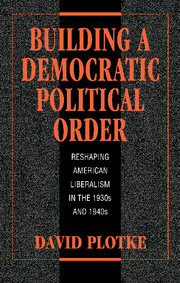Book contents
- Frontmatter
- Contents
- Preface
- Introduction: The Democratic order as a political project
- 1 When does politics change?
- 2 Creating political orders: the logic of the Democratic experience
- 3 Democratic opportunities in the crises of the 1930s
- 4 Passing the Wagner Act and building a new Democratic state
- 5 Party and movements in the Democratic upsurge, 1935–7
- 6 Progressive liberalism as pragmatic common sense
- 7 Surprising years: electing Truman and sustaining the Democratic order, 1947–9
- 8 Passing Taft-Hartley: what the losers won (and what the winners lost)
- 9 New political fronts? growth and civil rights in the 1940s
- 10 Democratic anti-Communism and the Cold War
- 11 From Truman to Kennedy: the reach and limits of Democratic power
- 12 Was the Democratic order democratic?
- Index
8 - Passing Taft-Hartley: what the losers won (and what the winners lost)
Published online by Cambridge University Press: 17 September 2009
- Frontmatter
- Contents
- Preface
- Introduction: The Democratic order as a political project
- 1 When does politics change?
- 2 Creating political orders: the logic of the Democratic experience
- 3 Democratic opportunities in the crises of the 1930s
- 4 Passing the Wagner Act and building a new Democratic state
- 5 Party and movements in the Democratic upsurge, 1935–7
- 6 Progressive liberalism as pragmatic common sense
- 7 Surprising years: electing Truman and sustaining the Democratic order, 1947–9
- 8 Passing Taft-Hartley: what the losers won (and what the winners lost)
- 9 New political fronts? growth and civil rights in the 1940s
- 10 Democratic anti-Communism and the Cold War
- 11 From Truman to Kennedy: the reach and limits of Democratic power
- 12 Was the Democratic order democratic?
- Index
Summary
Judging from experiences in Southern California, the provisions that have occasioned greatest criticism are those governing the conduct of employers prior to certification elections, the use of injunctions in the course of labor disputes, and the priority treatment given cases against unions. In a number of critical situations, these aspects of the Act have been used with telling effect to nullify the safeguards still supposedly enjoyed by unions under the law and to rob the unions of any real effectiveness as bargaining representatives of the workers.
– Dr. Frank Pierson, UCLA Institute of Industrial Relations, December 21, 1948.Dr. Pierson's negative judgment of the Taft-Hartley Act less than two years after its passage would surely have been rejected by that measure's proponents as hyperbolic and premature. Who would have been closer to the truth? To ask this question, given the centrality of political conflict about labor relations in the 1930s and 1940s, is virtually to ask whether the Democratic order survived the passage of a measure that all parties saw as significantly restricting trade unions. In the late 1940s what would a political rupture have looked like?
In terms of political support, a break with the Democratic order might have been achieved by the defection of core Democratic constituencies in several regions, or by an aggressive anti-Democratic mobilization of wide sections of the population who were not voting or otherwise participating in politics in the 1940s.
- Type
- Chapter
- Information
- Building a Democratic Political OrderReshaping American Liberalism in the 1930s and 1940s, pp. 226 - 261Publisher: Cambridge University PressPrint publication year: 1996



